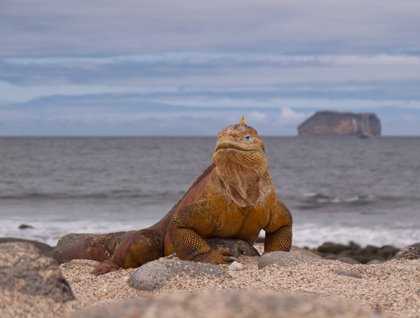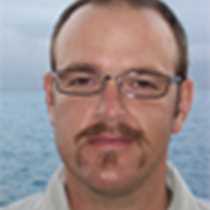After a small taste of the archipelago from our arrival, we are able to go in-depth on North Seymour Island. A flat nondescript island welcomes us as we start to disembark along the rocky coastline. Magnificent frigatebirds patrol the coast as the warm updrafts lift them above the island. Brown pelicans and blue-footed boobies make sporadic dives obtaining their subsistence for the day as frigatebirds consider stealing this hard-earned meal from them.
Heading inland we encounter frigatebird chicks awaiting a meal from their parents as they sit atop rickety nests that appear to fall apart as they rest upon them. Land iguanas slowly move in and out of the dry brush, and we come upon one that is trying—unsuccessfully—to rip apart a pad from the opuntia prickly pear cacti. We start to realize that the struggle for life is surrounding us and we find very unique creatures that have arrived at this point through a very hard selective process.
As our path brings us to the coast, male blue-footed boobies point at the sky and bring their wings forward with a very loud whistle with the intent of attracting a mate. The females appear to be uninterested as they turn their backs to the dancing boobies. A small snake slithers into the brush and we arrive back to our landing area with no desire to return to our ship as the intensity of this island starts to sink in.
Rabida Island welcomes us to its intensely red coloration. Due to the volcanic origins, there is a large amount of iron oxide trapped in the flows and cinders of the island. The underwater realm awaits us and we start our exploration with deepwater snorkeling along the coast. No one expects the water to be so cold given how close we are to the equatorial line. The Humboldt oceanic current bathes the archipelago in cold sub-Antarctic waters and we feel this immediately in this 66 degree F water. A white-tipped reef shark slowly passes beneath us among a school of razor surgeonfish. Small yellow-tailed damselfish maintain their algae gardens as large schools of black-stripped salemas pass closely overhead. Blue-chin parrotfish nibble upon the reef producing part of the sand that is found here. Leaving the water we are treated to a single Pacific green sea turtle being cleaned by small reef fish.
As the thick mist-ridden clouds cover the island we land for a short hike and the scenery does not disappoint us. Young Galápagos sea lions line the beach as a young pup, not more than a few weeks old, nurses with its mother. A Galápagos mockingbird runs back and forth among us and nearly runs into our feet as it searches for small insects. Gaining altitude allows us to examine our anchorage and enjoy the matted colors of the sunset over Isabela Island. Darkness closes our exploration as we return to our floating home, contented and curious about what tomorrow will bring.









